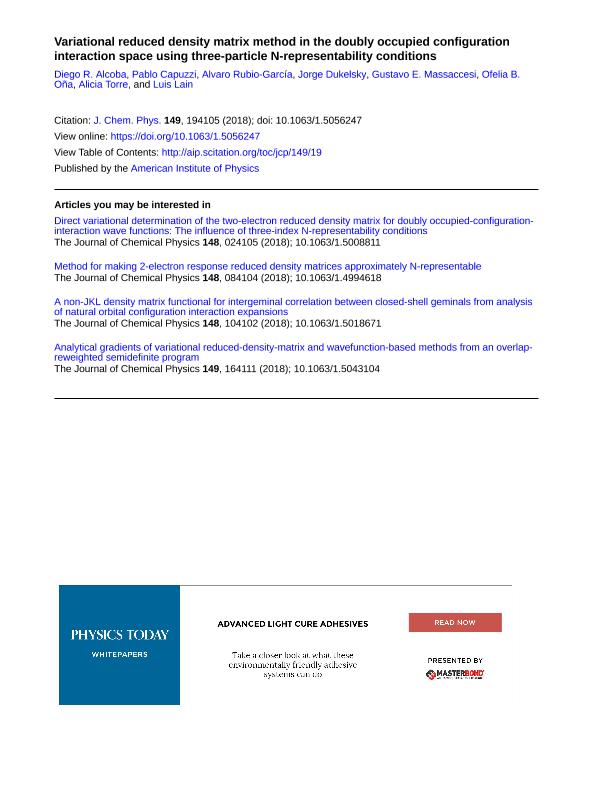Artículo
Variational reduced density matrix method in the doubly occupied configuration interaction space using three-particle N-representability conditions
Alcoba, Diego Ricardo ; Capuzzi, Pablo
; Capuzzi, Pablo ; Rubio García, Alvaro; Dukelsky, Jorge
; Rubio García, Alvaro; Dukelsky, Jorge ; Massaccesi, Gustavo Ernesto
; Massaccesi, Gustavo Ernesto ; Oña, Ofelia Beatriz
; Oña, Ofelia Beatriz ; Torre, Alicia; Lain, Luis
; Torre, Alicia; Lain, Luis
 ; Capuzzi, Pablo
; Capuzzi, Pablo ; Rubio García, Alvaro; Dukelsky, Jorge
; Rubio García, Alvaro; Dukelsky, Jorge ; Massaccesi, Gustavo Ernesto
; Massaccesi, Gustavo Ernesto ; Oña, Ofelia Beatriz
; Oña, Ofelia Beatriz ; Torre, Alicia; Lain, Luis
; Torre, Alicia; Lain, Luis
Fecha de publicación:
11/2018
Editorial:
American Institute of Physics
Revista:
Journal of Chemical Physics
ISSN:
0021-9606
Idioma:
Inglés
Tipo de recurso:
Artículo publicado
Clasificación temática:
Resumen
Ground-state energies and two-particle reduced density matrices (2-RDMs) corresponding to N-particle systems are computed variationally within the doubly occupied configuration interaction (DOCI) space by constraining the 2-RDM to satisfy a complete set of three-particle N-representability conditions known as three-positivity conditions. These conditions are derived and implemented in the variational calculation of the 2-RDM with standard semidefinite programming algorithms. Ground state energies and 2-RDMs are computed for N2, CO, CN-, and NO+ molecules at both equilibrium and nonequilibrium geometries as well as for pairing models at different repulsive interaction strengths. The results from the full three-positivity conditions are compared with those from the exact DOCI method and with approximated 2-RDM variational ones obtained within two-positivity and two-positivity plus a subset of three-positivity conditions, as recently reported [D. R. Alcoba et al., J. Chem. Phys. 148, 024105 (2018) and A. Rubio-García et al., J. Chem. Theory Comput. 14, 4183 (2018)]. The accuracy of these numerical determinations and their low computational cost demonstrate the usefulness of the three-particle variational constraints within the DOCI framework.
Palabras clave:
variational
,
three-particle density matrix
,
double occupation
Archivos asociados
Licencia
Identificadores
Colecciones
Articulos(IFIBA)
Articulos de INST.DE FISICA DE BUENOS AIRES
Articulos de INST.DE FISICA DE BUENOS AIRES
Articulos(INIFTA)
Articulos de INST.DE INV.FISICOQUIMICAS TEORICAS Y APLIC.
Articulos de INST.DE INV.FISICOQUIMICAS TEORICAS Y APLIC.
Citación
Alcoba, Diego Ricardo; Capuzzi, Pablo; Rubio García, Alvaro; Dukelsky, Jorge; Massaccesi, Gustavo Ernesto; et al.; Variational reduced density matrix method in the doubly occupied configuration interaction space using three-particle N-representability conditions; American Institute of Physics; Journal of Chemical Physics; 149; 19; 11-2018; 194105-194116
Compartir
Altmétricas



